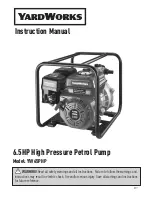
10
-
Be sure that no hydraulic hoses are stiff , which may indicate
trapped pressure.
5. If any hydraulic pressure remains, cycle the control valve(s)
again to relieve pressure. Then, re-check the hydraulic
pressure gauge(s) to be sure that no pressure is indicated.
7.0 INSPECTION, MAINTENANCE & STORAGE
• Periodically check the pump for loose hydraulic connections
leaks and obvious problems. Replace any damaged
components immediately.
• Monitor the pump oil temperature during operation. Do not
exceed oil temperatures above 150°F [65°C].
• Install dust caps and plugs on all hydraulic couplings after the
hydraulic hoses are disconnected from the pump.
• Keep the pump and all hydraulic components clean.
• Change the hydraulic oil at the recommended interval shown
in Section 8.2 of this manual. Change the oil immediately if
dirty, or if contamination is suspected.
• Store the pump in a clean, dry and secure location. Keep the
stored pump and hoses away from heat and direct sunlight.
• If repair parts are required, refer to the Milwaukee Cylinder
website (www.milwaukeecylinder.com) for the repair parts
sheet applicable to your pump model.
NOTICE
Hydraulic equipment must only be serviced by
a qualifi ed hydraulic technician. For repair service, contact
Milwaukee Cylinder customer service representative.
8.0 ROUTINE MAINTENANCE PROCEDURES
8.1 Preparation
Always perform the following steps before beginning any
maintenance or repair procedures contained in Section 8:
1. Disconnect the air supply hose and fully relieve pneumatic
and hydraulic pressure. Follow the steps in Section 6.3.
2. Disconnect hydraulic hoses from hydraulic manifold. Install
plugs in open ports.
3.
Position the pump on a workbench or other substantial work
surface.
NOTICE
Pump dry weight is approximately 71 lb [32.2 Kg]. This
fi gure does NOT include the weight of the hydraulic oil or the control
valves. Actual weight will vary, depending on amount of oil in
reservoir and number of control valves installed on manifold.
4. Remove the two screws located on either side of the pump
shroud. Remove the pump shroud and position it behind the
pump on the work surface. Be careful not to damage the
fl exible air tubing, which must remain connected. See Figure
12.
Figure 12 - Pump Shroud Removal
(Note: air tubing removed for illustrative purposes)
8.2 Oil Change
Change the hydraulic oil every 12 months. If the oil is dirty or
contaminated, change the oil immediately. Refer to the following
steps:
1.
Fully relieve pressure in the pneumatic and hydraulic circuits.
Disconnect hoses. Refer to maintenance preparation
procedures in Section 8.1 of this manual. Also refer to
pressure relief procedures in section 6.3.
2. Place the pump on a workbench or other substantial work
surface. To allow draining in the next step, position the pump
so that the side with the oil drain plug is even with the edge
of the workbench.
3.
Place a suitable container under the pump oil drain plug. The
container capacity must be 1.8 gallon [6.8 liter] or larger.
4. Slowly unscrew the oil drain plug and remove it. See Figure
13. Allow the old oil to fl ow into the container.
NOTICE
Dispose of used oil in accordance with all applicable
laws and regulations.
5.
Clean and reinstall the oil drain plug.
6.
Remove the oil fi ll plug. See Figure 4.
NOTICE
Use of Enerpac HF hydraulic oil is strongly
recommended. Refer to Section 5.3 for additional information.
7.
Slowly pour new oil through the oil fi ll opening while watching
the oil sight gauge. Continue until reservoir is 1/2 to 3/4 full.
DO NOT OVERFILL.
8.
Reinstall the oil fi ll plug.






































